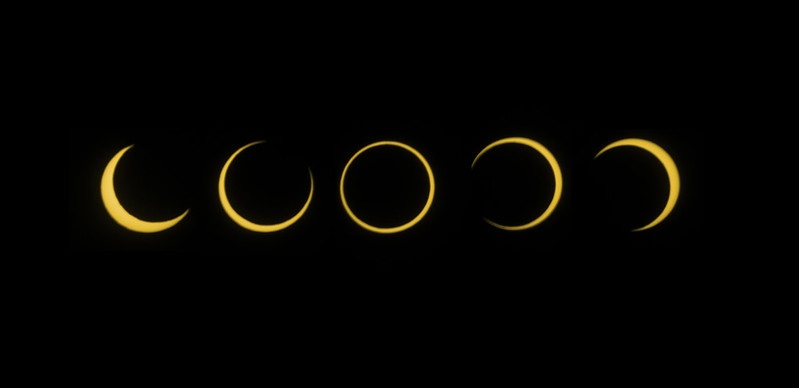Don’t miss the final solar eclipse of the year: a striking ‘ring of fire’ annular solar eclipse.
If skies are clear, observers across a swath of the western United States, Mexico, and Central and South America are in for a treat this coming Saturday, October 14th, as the antumbral shadow of the Moon crosses the Earth in a fine ‘ring of fire’ annular solar eclipse.
Annulars vs. Total Solar Eclipses
Annular solar eclipses occur when the Moon is in the farthest span of its elliptical orbit when it passes in front of the Sun, and fails to cover the solar disk completely. This weekend is a case in point, as the Moon reaches apogee just four days prior to New phase and eclipse. The bright annulus seen around the Sun during an annular eclipse has, in recent years, gained popularity as a ‘ring of fire’ solar eclipse.

Fun fact: in the current 5,000 year epoch annulars are actually more common than total solar eclipses, to the tune of 33.2% annulars, to 26.7% totals… the remainder being hybrids and partials. This is even becoming more so, as the Moon recedes from the Earth. In about 600 million years time, the final total solar eclipse will occur. We live in a fortunate time, indeed.

Saturday’s Eclipse Path
The path of the eclipse makes landfall over the Oregon Pacific coast around 16:15 Universal Time (UT), before racing at over 7,500 mph across NE California, Nevada, Utah, Colorado, Arizona and Texas. The path then heads out over the Gulf of Mexico, crossing land again over the Yucatan peninsula and central American countries of Belize, Honduras, Nicaragua and Panama, before crossing South America through Columbia and Brazil and departing over the southern Atlantic.
Maximum annularity for the eclipse is just over 95% obscuration, and 5 minutes 17 seconds long near the southern border of Nicaragua. Interestingly, the path also crosses over the Four Corners monument, National Bridges National Monument in Utah, and Chaco Culture National Historic Park in New Mexico. Mid-eclipse occurs at 17:59 UT on October 14th.
Keep in mind, all of North America and most of South America outside of the path will still see various degrees of partial phases for the solar eclipse. Phenomena to watch for include Baily’s Beads near the edge of the eclipse path, and horizon-hugging ring of fire with ‘eclipse horns’ over the sea along the Pacific northwest at sunrise, and sinking into the Atlantic Ocean at sunset.

1. Albuquerque NM at 10:37 AM MDST (Sun’s altitude: 36 degrees)
2. Juneau AK at 8:13 AM ADST (Sun’s altitude: 4 degrees)
3. Bristol TN at 1:12 PM EDT (Sun’s altitude: 45 degrees)
4. Miami FL at 1:22 PM EDT (Sun’s altitude: 56 degrees)
Approximate times to watch for mid-partial eclipse across the United States (in Daylight Saving Time) are near 1:20 PM Eastern Time, Noon Central Time, 10:45 AM Mountain Time and 9:20 AM Pacific Time.

Solar Viewing Safety
Unlike totality during a total solar eclipse, you’ll need to use proper eye protection during all phases of an annular eclipse… even just 5% of the Sun is still pretty darned bright. Eclipse glasses marked ISO 12312-2 will work fine to view the eclipse, as will glass or Baader solar film filters that affix securely to the front end of the optics.
You can also photograph the eclipse using a properly filtered DSLR equipped with at least a 200mm fixed or zoom lens. To grab foreground when the Sun is at a low horizon angle along with the eclipse, use a high neutral density filter. Be sure to physically block out the camera’s view finder, and only use the digital view finder for focusing and acquisition.
Projection is also another safe way to observe and eclipse. Be forewarned when using optics to do this though; be sure to give the equipment cool down time, so as not to overheat and cause damage. You can even note this natural effect through ‘pinhole’ gaps between tree leaves or open lattice work, casting hundreds of tiny crescent suns on the ground. You can even create this effect by using a cheese grater or spaghetti strainer. And how about… a ‘disco ball eclipse?’
‘Ring of Fire’ Citizen Science
Several citizen science projects are underway during the eclipse, NASA has a suite of projects, and there’s also the Atmospheric Perturbations around the Eclipse Path (APEP) mission, with a series of sub-orbital rocket launches from White Sands, New Mexico to measure weather and atmospheric changes during the eclipse.
To my eye, the sky tends to take on a deep steely blue tint at the peak of an annular eclipse… would you notice that anything was amiss, if you didn’t know better? Keep an eye out for -4.6 magnitude Venus at mid-eclipse, about 46 degrees west of the Sun.

Watching the Ring of Fire Eclipse Live, Weather Prospects and More
Although we’re currently headed towards solar maximum for Cycle No. 25, the Sun is relatively quiet this week, with few photogenic sunspots turned Earthward. Weather and cloud cover eclipse day also currently favors the southern U.S., though views of the crescent Sun filtered through broken clouds can appear especially dramatic.

We also typically get great views of the eclipse from space. ESA’s Proba-2 solar satellite often catches eclipses from its vantage point in low Earth orbit. The GOES series of weather satellites also see of the shadow of the Moon racing over the surface of the Earth during solar eclipses.
Clouded out, or simply live in the wrong hemisphere? You can catch the eclipse live starting at 16:30 UT on October 14th, courtesy of astronomer Gianluca Masi and the Virtual Telescope Project.
This ‘Ring of Fire’ eclipse is special in another way: it’s the final solar eclipse until the ‘big one…’ the next total solar eclipse spanning Mexico, the United States and Canada on April 8th, 2024. Get those eclipse glasses ready and prepare, as ‘eclipse fever’ sets in across North America.

